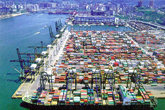Millions of cubic metres of contaminated sediment will be dredged from the seabed at Kwai Chung to allow larger vessels to dock in Hong Kong, but a local academic warns the move may pose an environmental danger, the South China Morning Post reported.
Government engineers plan to remove the sediment to deepen to 17m the terminal basin and part of the channel leading to the port at the Kwai Chung container terminal.
This would allow it to handle ultra-large cargo ships even during low tide.
However, it is estimated the work will generate at least 5.5 million cubic metres of contaminated mud. One-fifth of it may have to be dumped in a confined seabed pit.
An environmental impact assessment would be carried out, the government says.
Michael Lam Hon-wah, a professor on environmental chemistry at Hong Kong's City University, said dredging the seabed could distribute heavy metals into the water, which could later re-enter the food chain.
Professor Lam said Kwai Chung was an industrialised area, where untreated sewage in the past had been discharged around the nearby seabed.
In addition, many ocean-going ships coated with chemicals might also have deposited the metals onto the seabed.
A 2006 Marine Department review on the implication of next-generation container ships on Hong Kong's port said the seabed should be dredged to a depth of at least 15m to prepare for giant ships.
CargonewsAsia













